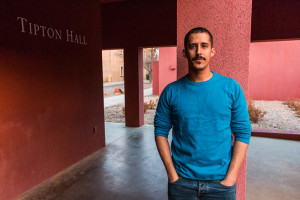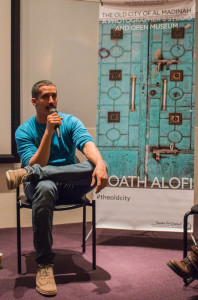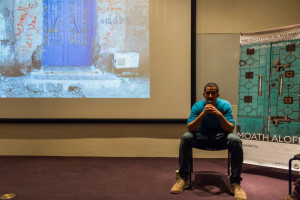Tags
Related Posts
Share This
Photographer Moath Alofi Visits SFUAD

Photographer Moath Alofi did a presentation on his work for the students of Santa Fe University of Art and Design. Photo by Yoana Medrano.
“Sometimes your journey for glory starts from the inside not the outside.”
These are the words written beneath a spinning Mandela on the presentation screen Dec. 2 in Tipton Hall. Saudi Arabian photographer Moath Alofi stands at the podium and smiles at the modest audience. He takes the projector’s remote control in his hands and flips to the first slide of his presentation: a picture of the Prophet’s Mosque in the holy city of Al Madinah glowing in soft white light against a navy blue night sky.
Al Madinah is well traveled by many Muslims. For Alofi, who grew up in the city, it is surrounded by many memories. After attending university in Australia, he returned to the holy city in 2013.
“My father took photographs of some of the old structures and I was overcome by a feeling of nostalgia,” Alofi recalls. “So I started taking pictures of still images with my mobile phone of whatever interested me around the city.”
Alofi began posting his iPhone photographs on his Instagram account where he gradually gained thousands of followers. “I started to meet with people who were interested in Al Madinah,” Alofi says. “We would go around the city and take pictures. But then we decided to take it further and explore the entire region.”
After assembling an aerial team consisting of pilots, photographers and doctoral students, Alofi took to the sky and began photographing landmasses and ancient structures around the Saudi Arabian region.

Moath Alofi answering questions after his talk on his work from The Old City of Al Madinah. Photo by Yoana Medrano.
One picture he shows of the Khaybar Volcano features a huge sand dune with a vast, open crater at the top. Pale sand runs down the crater’s rim like thick locks of wavy, light brown hair trailing down the side of the dune. Another picture shows a small, rectangular structure sitting along in the desert against a dark sky, its tiny square windows pitch black.
“They are little houses where people traveling in the desert can rest,” Alofi says. “They can stop moving, pray and drink water.”
Alofi is saddened by the state of these little mosques, which have been left in a state of disrepair. He calls them “The Last Tashahhud,” which means “The Last Breath.”
“It’s an abandoned house of God. It shouldn’t be empty,” he says. “It should be functioning all the time. It should be a place to seek, not to leave behind.”
Currently, Alofi is working on a project called “Doors of Barlik,” which discusses the changes Al Madinah is going through due to the city’s expansion. A picture of an old wooden door, painted blue and engraved with intricate flowers, appears on the projector screen. A red, spray-painted number cuts across the door—a compensation number. The family living in the marked house takes their compensation number to the Ministry of Finance to get reimbursed for the house that have been chosen to be knocked down.
“Some of these houses are up to 200 years old,” Alofi says. “They’re in bad condition. The people living in them haven’t kept them up.”
He finds doors from sites where the houses have been demolished, and then he buys the ones that speak to him.
“Sometimes I’ll find children’s writing on the doors,” Alofi says. “These houses were lived in, the doors tell stories about the families that have lived in them.”

Photographer Moath Alofi answering a question about a serial number that was spray-painted on a home that was about to be demolished. Photo by Yoana Medrano.
He hopes that his photography will teach people that Al Madinah’s old houses are treasures that need to be saved and not destroyed. The Ministry of Heritage and Antique is also trying to preserve these old houses.
Alofi plans to continue collecting and shooting doors, and wants to continue educating future generations about Saudi Arabia’s landscapes and Al Madinah’s ancient treasures.






 Jackalope Magazine is the student magazine of Santa Fe University of Art and Design. Building on the interdisciplinary nature of our education, we aim to showcase the talent of our university and character of our city.
Jackalope Magazine is the student magazine of Santa Fe University of Art and Design. Building on the interdisciplinary nature of our education, we aim to showcase the talent of our university and character of our city.
There is more history in the city than meets the eye, its harsh surroundings are also glimpses of the vastness that is the surrounding desert and its inhabitants. Moath is able to depict them in his photographs, waita go my friend!